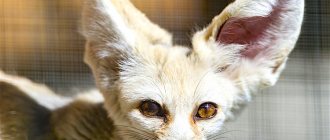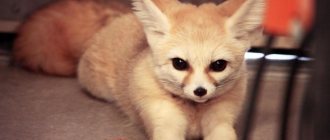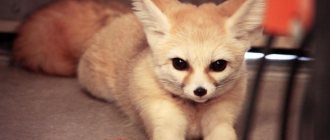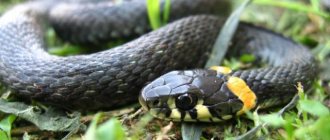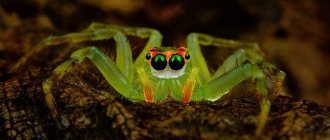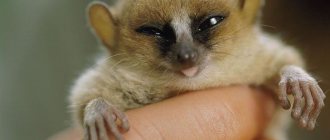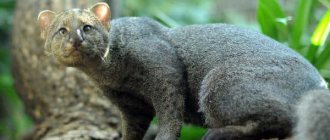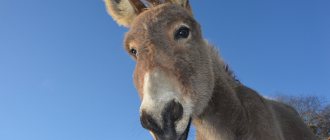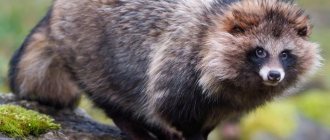Fans of exotic animals keep a variety of pets, and the domestic fox is one of them. Slowly they are beginning to develop both country houses and city apartments. Before deciding on such cohabitation, it is worth studying all the features of this animal and its contents.
What kind of foxes can you keep at home?
Many people are surprised at the possibility of keeping such animals, so the question is whether it is possible to keep a fox at home. The answer is positive, but this does not apply to all representatives of the breed. An animal that was brought from the forest and simply began to accustom itself to life in human conditions will sooner or later begin to show its instincts. You need to choose the fox that you can have at home:
- Domestic fox
, bred from the common fox - red, less often - black-brown. Its weight reaches 6 kg, its muzzle is more rounded than that of a wild one, its ears are drooping, its tail is curved at the top. - Fennec fox
is an African desert fox. It is distinguished by its tiny size (2 kg), huge ears (15 cm) and long tail (30 cm), and expressive eyes. The color of six is red or sand.
Types of tamed animals
Today, exotic animals are kept not only in luxury country houses, but also in ordinary city apartments. Many people prefer bushy-tailed beauties - foxes. These pets attract attention with their pretty appearance and perky disposition.
It's hard not to fall in love with such a charming creature. However, one must take into account that it will have to be carefully and competently looked after. If you keep a fox incorrectly, it can lead to dire consequences.
People who want to get such a furry friend are interested in the question: which foxes are considered tame and domesticated? Let's take a closer look at which breeds can be kept at home.
Silver fox
At one time, scientists conducted many experiments on the domestication of wild foxes. As a result, it turned out that silver foxes are the most susceptible to this process.
The beautiful silver fox is tamed easily and quickly. She remembers her owner. If you provide such a gorgeous pet with all the necessary conditions of detention, then in captivity he will feel great.
The length of a silver fox can reach 60-90 cm. It is characterized by a chic fluffy tail, which can grow up to 60 cm. The average weight of a silver fox is 10 kg.
The fur can have different colors. Some individuals have exclusively black coat color, and the tip of their tail contrasts with white color. There are also individuals whose fur is distinguished by an unobtrusive brown or bluish tint, and their sides are gray-ashy.
Experts strongly recommend purchasing a silver fox puppy from a specialized nursery or pet store. If the person who sells such an animal does not have all the necessary documents, then it is better not to take the pet.
The silver fox is a calm individual. If there is no aggression towards it from a person and the animal does not feel danger, then it will not hide and be afraid, and will easily make contact. The movements of the silver fox are calm and unhurried. If you scare her, she will immediately stretch out her fluffy tail and run away with incredible speed.
Common Red
In Russia, the common red fox is also a domesticated animal. The coat color of this pet can have many different shades. There are both rich red and grayish individuals. The classic and most common coat color includes a white or light yellow chest and belly, the tips of the paws and ears are black, and the tip of the tail is usually snow-white.
Domestic artificially bred red foxes can weigh between 10 and 15 kg. Their forest relatives grow smaller and neater, their average weight is only 5–6 kg.
The common red fox is a very energetic and playful pet. She is playful, has a strong immune system, and therefore rarely gets sick.
fennec
The desert fennec fox is another fox that can be kept as a pet. It makes no sense to compare this fox with ordinary dogs or cats, but they still have certain common features. Fennec cats are about the same size as small cats. Their habits and behavioral characteristics are also similar.
In desert foxes you can notice the slight detachment characteristic of domestic cats. These animals have adopted playfulness and energy from dogs.
The fennec fox may seem like a real plush toy, but we must not forget that it is a wild animal. Such pets usually do not require complex care. They can even be trained to use the tray, although in rare cases this can be avoided without occasional mistakes.
How much does a pet fox cost?
Since 2011, domestic foxes have been offered by the Novosibirsk Institute of Cytology and Genetics. They are tame, safe and friendly. Such an animal is now easy to buy; a domestic fox will cost $200-500, depending on the severity of color and species qualities. Be wary of animals that cost less than $150. More often these are nondescript puppies, possibly wild - such a purchase can have negative consequences. Fennec foxes are not cheap - up to $2 thousand per fox. Many nurseries sell such animals; they have the appropriate certificates.
Fox cubs
Pregnancy in foxes lasts 51 - 52 days. By the end of this period, the males' paternal instinct awakens. They look for pregnant females and again fight with rival males, this time for the right to stay near the female. From now on, the winner takes upon himself all the hardships of family life: he helps dig a hole, feeds the fox at a time when she cannot yet leave the newborns, and shares with the female the responsibilities of raising young foxes. Fox cubs usually appear in late April or early May.
At first they are brown in color and very similar to puppies, but they all have a distinctive feature - the white tip of the tail. The young generation grows up quickly; by the 20th day of life they already begin to crawl out of the hole and feed not on mother’s milk, but on live food. It is not easy for the father of the family to feed his voracious cubs, so the female begins to help in obtaining food. Parents not only bring live mice, birds and small animals into the hole, but also begin to teach their kids the basics of hunting. At first, the fox cubs hunt for May beetles and grasshoppers, but gradually they become accustomed to preying on larger game: voles, lizards, and frogs.
Fox cubs grow quickly, and already in August they are difficult to distinguish from an adult animal from a distance. In November, young foxes begin an independent life and scatter in all directions.
Fox in the house - pros and cons
Before buying an exotic animal, it is important to know what to expect from such a pet and evaluate your capabilities. Domestic fox - pros and cons as a pet:
- An active and inquisitive animal, loves games, you won’t get bored with him.
- They prefer warmth and care, they are loyal.
- They easily adapt to any type of food and are not expensive to maintain.
- It smells, and is strong and unpleasant.
- The domestic fox marks its territory, even the female.
- The predator screams at night and can bite.
- Jumps high, especially the fennec.
- The fox is a burrower, you need to be prepared for the fact that it will dig - on the sofa, under the sofa and in other places.
- Pet hamsters, rabbits, and chinchillas are prey for her, not friends.
Habitat
The lifespan of a fox is influenced by the condition of the area where a pair of animals or a whole family lives. This area should provide the animals with the necessary amount of food, and also be suitable for creating burrows. Foxes dig them on their own, but sometimes they can occupy the empty homes of arctic foxes, marmots and badgers. However, there were cases when the animal lived together with the badger, but in separate burrows.
The fox prefers to settle on the slopes of hills and ravines with sandy soil. This place should be protected from melt and groundwater, as well as from heavy rains. As a rule, a fox hole has several entrances, each of which leads to a nesting chamber. Often the animal uses natural shelter: a hollow, a rock crevice, or the hollow of a thick tree. The fox's home is densely covered with thickets, but it is revealed by long paths, large soil emissions near the entrances, excrement and food remains.
The fox uses permanent shelter only during the period of feeding its offspring; the rest of the time it rests on the grass, in the snow or in an open den. To escape pursuit, the animal can use any hole that comes along the way. While raising babies, a fox may move to another shelter several times due to the appearance of parasites.
Domestic fox - character
By their nature, domestic foxes are independent, but they trust their owner. They adapt well to a person’s mood and do not like to be alone. Foxes have a good memory and are quick-witted. It is easy to establish contact with them; pets are inquisitive and prone to obedience. These animals cannot be punished - they are vindictive and can become aggressive. A tame fox walks freely on a leash; it is better to walk it in the evening.
The fox is a friendly and playful animal, loves to climb into boxes and run after a ball. She gets along well with other large animals. An adult domestic fox and a cat are by and large indifferent to each other. They are capable of showing aggression in order to protect their offspring. A small puppy and a kitten can become friends: sleep together, frolic, warm each other. A domestic fox and a dog often keep their distance, but can become friends, especially if the kids grow up together from childhood.
Enemies: who eats foxes in nature
Cunning and cautious animals have plenty of ill-wishers:
- the Bears;
- wolves;
- wolverines;
- large predatory cats;
- dogs;
- badgers;
- feathered predators.
Weak cubs are often attacked by hawks, crows, and eagle owls.
The main enemy of foxes is man. People traditionally hunt these animals for their luxurious fur, sometimes just for sport.
An adult fox is by no means an easy prey. The animal runs fast, swims well, masterfully confuses its tracks, and hides well. If necessary, a predatory animal will pretend to be dead and climb a tree.
Domestic fox - content
To make an animal feel comfortable at home, you have to try. There are tips on how to keep a fox at home:
- It is better to keep such animals in an outdoor enclosure and move them indoors in winter. In an apartment, the animal needs a large cage.
- The house must be strong and stable; these animals can dig and jump high. The fox's home should always be clean.
- Keeping a fox at home is a troublesome task. To socialize the animal, it needs walks - once a day is enough for this.
- Foxes love to hide, they need to equip something like a den.
- As a toilet, you can use a box with sand or a tray with filler. Individuals easily learn to relieve themselves there carefully.
What to feed a fox at home?
These furry pets are omnivores and there are no problems with feeding them. If a fox lives at home, it will need a balanced diet, as close as possible to the food that animals get in natural conditions. It is good to give your pets cereal porridge with vegetables, add fish and meat there. Animals can be offered fruits - plums, pears, apples. Like dogs, domestic foxes should not be given sharp bones or raw foods.
They will like pork or beef cartilage, chicken giblets, lungs, liver, and spleen. In general, the diet of chanterelles is not much different from the menu of cats and dogs. It must be of high quality, filled with minerals, vitamins, and amino acids. Balanced dry dog food is excellent for foxes. However, you should not feed them such food all the time.
Nutrition
Of course, nutrition has a great influence on the lifespan of a fox. Although the animal is a predator, it can eat different foods. The main food that a fox eats includes more than 400 species of animals and several dozen plants. The diet of this animal is based on field rodents. The population and life expectancy of the fox depend on the availability and sufficient quantity of such food. This is especially important in winter, when the animal hunts voles. The fox catches the scent of a rodent, listens to the slightest rustle, and then suddenly dives into the snow and grabs it with its teeth.
Larger animals, such as hares, are not so attractive to the fox, although they also sometimes fall into her paws, especially little hares. During the period of hare pestilence, a fox may not disdain even a corpse. There have been cases when large individuals attacked a roe deer calf, as well as large birds that found themselves on the ground. Foxes can also destroy a clutch of eggs and steal poultry. In Canada, for example, these animals feed on salmon that died after spawning, and in the summer they are content with insects and various beetles. Among plant foods, berries, fruits, fruits, and vegetative parts can be noted. Foxes often cause significant damage to oat crops, as they eat them during the period of milky ripeness.
How long does a domestic fox live?
Some breeders claim that with proper feeding and care, a fox at home can live up to 20 years. In the wild, the age of red cheats, on average, reaches 7 years, but it is influenced by many factors. Foxes are constantly under stress and are forced to get their own food. They move a lot, have constant fights over territory, and get sick due to the cold climate. At home, the fox is calm, warm, and eats well. If diseases occur, the veterinarian will be able to immediately provide the animal with the necessary assistance, so its life expectancy increases significantly.
Description
In different parts of the world, the size and color of the fox differ. In total, there are about 50 subspecies of this animal, excluding its small forms. If you move north, you will notice that the foxes become lighter and larger, while in the south they are dull colored and small. In the mountains and northern regions you can find the black-brown fox. The most common color: dark paws, white belly and bright red back. Often the animal has brown stripes on its shoulder blades and spine, which are arranged in a cross. Common distinguishing features include a white-tipped tail and dark ears. Despite such a large number of different animal species, the life expectancy of a fox in every corner of the planet is approximately the same.
The fox is a medium-sized animal with an elongated muzzle, an elegant body, a fluffy long tail and pointed ears. In February-March the animal begins to shed, and this process ends in mid-summer. It is then that the fox begins to develop winter fur, which it acquires by November-December. In winter the fur is very lush and thick, and in summer it is short and sparse. For the fox, the ears are assistants in catching prey; they are large and resemble locators. With the help of these organs, the animal detects sound vibrations that come from a potential victim.
Further research[edit]
These results led Institute scientists to study the domestication of other animals, such as rats in 1972, mink and river otter. [19] A similar study was conducted in Denmark with American minks. [20] The project also bred the least tameable foxes to study the social behavior of dogs. These foxes avoided human contact, similar to their wild behavioral phenotypes. [21] [3]
Trut and his colleagues conducted detailed genetic and physiological studies of these foxes. For example, the "star" pattern was found to be controlled by a single dominant gene that was not completely penetrant, "but its penetrance is significantly higher in offspring from tame mothers than from aggressive ones..." [22] Truth reported that female foxes heterozygous for The gene that controls star formation also affected the number of male cubs, increasing the number of males by more than the expected 50%. Additionally, as the fox experiment progressed over time, it was found that overall the number of male cubs increased from the expected 50% to approximately 54%. [23] At the beginning of the experiment, Trut and Belyaev began to compare the hormonal reactions of tame and control foxes. [11] [21] They showed that selection for domestication behavior leads to decreased levels of 11-hydroxycorticosteroids in the blood; selection also caused changes in adrenal morphology. Levels of the sex hormones estradiol and progesterone varied. Belyaev stated: “Perhaps the most important observation emerging from this series of experiments is the fact that domesticated females show statistically significant changes in certain neurochemical characteristics in brain regions such as the hypothalamus, midbrain and hippocampus. The level of serotonin and its metabolite 5-hydroxyindoleacetic acid was higher in tame than in non-tame women. This fact is consistent with the type of behavior, since serotonin is known to suppress some types of aggression. In addition, serotonin plays a role in the central regulation of hypothalmology. pituitary-adrenal-sexual system. Thus, selection for domesticated behavior is associated with changes in both central and peripheral mechanisms of neuroendocrine control of ontogeny.”[11]
Truth and her colleagues applied modern molecular techniques to fox populations to not only determine which genes are involved in domestication, but also to determine how changes in the fox genome relate to changes in the domestic dog genome. [24] [25] [26] [27] In the fox genome, 400 canine microsatellites were analyzed, which are evenly distributed throughout the canine genome. Based on the degree of homozygosity in both tame and aggressive foxes, it was found that there was no evidence of inbreeding between the two groups of foxes. In addition, to help understand the neurobiology of behavior, orthologues of the serotonin receptor genes in foxes and dogs have been cloned. [24] Using 320 microsatellites, Truth and colleagues showed that all 16 fox autosomes and one X chromosome were covered, and that there was a high degree of marker order conservation between homologous regions of foxes and dogs, even though the fox genome has 16 pairs of metacentric autosomes, and the dog has 37 pairs of acrocentric autosomes. [25] Additional studies by these researchers showed that tameness and aggressiveness were associated with at least two loci. [27]
In 2005, DNA microarrays were used to detect differences in genetic expression in domesticated, non-domesticated (farmed) and wild foxes. It was found that there is a difference of forty gene expressions between domesticated and non-domesticated foxes. Although differences were observed in the genes of the three groups, the experimenters did not study the behavioral and functional consequences of these differences. [28] In 2007, a system for measuring fox behavior was described that is expected to be useful in QTL mapping to study the genetic basis of fox domestication and aggressive behavior. [29]
Breeding for aggression[edit]
As he began his selective breeding program for domestication, Belyaev also began breeding a line of fearsome, aggressive foxes. [6] In addition, he began to domesticate other animals. He and his team began working with rats in 1972, and then with minks and, briefly, river otters, although this latter experiment was abandoned because the species "proved difficult to breed." However, experiments with rats and minks were successful, and the subjects became domesticated along with foxes. [14] After Belyaev’s death, his experiment on rats was continued by Irina Plyusnina. “Siberian gray rats, caught in the wild, are bred separately for domestication and cruelty,” reports The New York Times.
, “evolved... completely different behavior in just 60 or so generations,” reports
the Times
. [8] When geneticist Svante Pääbo was in Novosibirsk in 2003, he visited the institute and was “stunned” by two groups of rats. “In just 30 years of selection,” Pääbo said, “IC&G researchers have created two populations that could hardly be more different.” [15]
In 2006, Frank Albert, a graduate student at the Institute of Evolutionary Anthropology. Max Planck in Leipzig, Germany, helped continue Belyaev's work by studying the genetic roots of the differences between tame and hyperaggressive rats. [8] In 2009, Albert and several of his colleagues published a paper in the journal Genetics about the results of their crossbreeding of tame and hyperaggressive rats, which they created in Leipzig. [30] In 2011, it was reported that Albert's team had "discovered several key regions of the genome that strongly influence domestication" and that they suspected "at least half a dozen genes" were involved. The next step was to “find individual genes that influence tameness and aggression.” [15]
“Understanding what has changed in these animals will be incredibly informative,” Elaine Ostrander of the National Human Genome Research Institute at the National Institutes of Health told National Geographic in 2011. “Everyone is looking forward to seeing them come out. With." [14]
Menu
Fennec foxes are predators. In the wild, their diet is very varied. They find eggs, catch small vertebrates: reptiles, small birds, insects. They love locusts. Chanterelles also know how to dig up roots and tubers of plants and get fruits from trees. Plant products provide animals with the necessary moisture, so they are an integral part of the daily diet.
When kept at home, these animals prefer raw meat, fruits and vegetables. Also, the fennec will not refuse small rodents, lizards or his favorite locusts. Sometimes the animal can be pampered with fermented milk products, fish or eggs.
Fennec foxes are wonderful domestic foxes, the price of which is very high. These miniature creatures are unusually affectionate and gentle animals, and after appropriate education they also become very smart.
As you can see, a domestic fox is a completely achievable goal. But you should always remember that no matter how obedient your pet is, it always remains a wild animal, capable of becoming uncontrollable at any moment. And at the same time, a fox can become an excellent companion, good-natured and playful, who gets along well with a person.
Links[edit]
- Darwin, Charles (1859). "1". On the Origin of Species by Means of Natural Selection, or the Preservation of Favored Races in the Struggle for Life
(reprinted 1963). Norwalk, CT: Heritage Press. item 470. - ^ abcdefgh Trut, Lyudmila (1999). "Early Canid Domestication: An Experiment with Farm Foxes." American scientist
.
87
(2): 160. Bibcode: 1999AmSci..87….. T. DOI: 10.1511/1999.2.160. JSTOR 27857815. - ^ abcd Trut, Lyudmila; Dugatkin, Lee Alan (23 March 2022). How to Tame a Fox (and Build a Dog): Visionary Scientists and a Siberian Tale of Accelerated Evolution
(1st ed.). Chicago: University of Chicago Press. p. 240. ISBN 978-0226444185. - "Famous fox domestication experiment disputed". Scientist Magazine®
. Retrieved January 6, 2022. - ^ abcd Lord, Catherine A.; Larson, Greger; Coppinger, Raymond P.; Karlsson, Elinor K. (2020). "Farm fox story undermines animal domestication syndrome". Trends in Ecology and Evolution
.
35
(2): 125–136. DOI: 10.1016/j.tree.2019.10.011. PMID 31810775. - ^ abcdefghij Goldman, Jason (September 6, 2010). “Man's new best friend? The Forgotten Russian Experiment in Taming Foxes". Scientific American. Retrieved May 23, 2014.
- "Darwin's Dark Knight: Scientist Risks Execution for Fox Research (Op-Ed)". Living Science
. Retrieved October 2, 2022. - ^ abcdefghi Wade, Nicholas (July 25, 2006). "Good rats, nasty rats: maybe it's all in the genes". New York Times
. Retrieved May 23, 2014. - Bidau, Claudio J. (2009). "Domestication through the centuries: Darwin's ideas and Dmitry Belyaev's long-term experiment with silver foxes". Guyana (Concepcion)
.
73
: 55–72. DOI: 10.4067/S0717-65382009000300006. - ^ ab Trut, Lyudmila N. (1999). "Early Canid Domestication: An Experiment with Farm Foxes." American scientist
.
87
(2): 160–169. Bibcode: 1999AmSci..87…..T. DOI: 10.1511/1999.2.160. - ^ a b c d e Belyaev DK (1978). "Destabilizing selection as a factor in domestication." Journal of Heredity
.
70
(5): 301–308. DOI: 10.1093/oxfordjournals.jhered.a109263. PMID 528781. - ^ a b Dugatkin L.A.; Trut, L.N. (2017). How to Tame a Fox (and Build a Dog): Visionary Scientists and a Siberian Tale of Rapid Evolution
. Chicago: University of Chicago Press. item 240. - "Domesticated Foxes: Man's New Best Friend?" . NPR. March 18, 2012. Retrieved June 16, 2014.
- ^ abcdef Ratliff, Evan (March 2011). "Taming the Wild". National Geographic. Retrieved May 23, 2014.
- ^ abc Nicholls, Henry (5 October 2009). "My Little Zebra: Secrets of Taming". New scientist. Retrieved June 16, 2014.
- "Domestication of foxes and problems of modern animal husbandry". www.bionet.nsc.ru
. Retrieved July 5 +2016. - "Why Domesticated Foxes Make Genetically Attractive (and Terrible Pets)". pbs.org
. 2017-03-31. - Hare, Brian; and others. (2005). “Social cognitive evolution in captive foxes is a concomitant byproduct of experimental domestication.” Current Biology
.
15
(3): 226–230. DOI: 10.1016/j.cub.2005.01.040. PMID 15694305. S2CID 1592440. - ^ab Ratliff, Evan (March 2011). "Taming Animals: Taming the Wild". National Geographic
. paragraph 2. Archived November 22, 2015. - Price, Edward (2008). Principles and Applications of Pet Behavior. Cambridge University Press. p. 229. ISBN 9781780640556. Retrieved January 7, 2016.
- ^ ab Trut, Lyudmila N.; Oskina Irina N.; Kharlamova, Anastasia V. (2012). "Experimental studies of early canid domestication". In Ostrander, Elaine A.; Ruvinsky, Anatoly (ed.). Dog genetics
(2nd ed.). CAB International. pp. 12–37. ISBN 9781845939410. Retrieved January 12, 2016. - Belyaev, DK; Ruvinsky, JSC; Trut, L.N. (1981). "Inherited activation-inactivation of the star gene in foxes: its relevance to the problem of domestication." Journal of Heredity
.
72
(4):264–274. DOI: 10.1093/oxfordjournals.jhered.a109494. PMID 7288139. - Trut, L. N. (1996). "Sex ratios in silver foxes: effects of domestication and the star gene." Theoretical and applied genetics
.
92
: 109–115. DOI: 10.1007/s001220050100. - ^ a b Kukekova A.V. Trut, L.N.; Oskina I.N. Kharlamova A.V.; Shikhevich S.G.; Kirkness, E.F.; Aguirre, G. D.; Acland, G. M. (2004). "A set of markers for constructing a genetic map of the silver fox (Vulpes vulpes)". Journal of Heredity
.
95
(3):185–194. DOI: 10.1093/jhered/esh033. PMID 15220384. - ^ a b Kukekova A.V. Trtu, L.N.; Oskina I.N. Johnson, J.L.; Temnykh, NE; Kharlamova A.V.; Shepeleva, DV; Gulievich, R.G.; Shikhevich S.G.; Grafodatsky A.S.; Aquirre, G. D.; Acland, G. M. (2007). "Meiotic linkage map of the silver fox, aligned and compared to the dog genome". Genomic Research
.
17
(3):387–399. DOI: 10.1101/gr.5893307. PMID 17284676. - Kukekova, A.V.; Trut, L.N.; Chase, K.; Shepeleva, DV; Vladimirova, A.V.; Kharlamova A.V.; Oskina I.N. Stepika, A.; Klebanov, S.; Erb, H.N.; Acland, G. M. (2008). "Measuring segregation behavior in experimental silver fox pedigrees". Behavioral genetics
.
38
(2): 185–194. DOI: 10.1007/s10519-007-9180-1. PMC 2374754. PMID 18030612. - ^ a b Kukekova A.V. Trut, L.N.; Chase, K.; Kharlamova A.V.; Johnson, J.L.; Temnykh, NE; Oskina I.N. Gulevich, R.G.; Vladimirova, A.V.; Klebanov, S.; Shepeleva, DV; Shikhevich S.G.; Acland, G.M.; Lark, K. G. (2011). "Mapping loci for fox domestication: behavioral phenotype deconstruction/reconstruction". Behavioral genetics
.
41
(4):593–606. DOI: 10.1007/s10519-010-9418-1. PMC 3076541. PMID 21153916. - Lindberg, Julia; Björnerfeldt, Suzanne; Saetre, Peter; Swartberg, Kent; Seehuus, Birgitte; Bakken, Morten; Vila, Carles; Yazin, Elena (2005). “Selection for domestication altered gene expression in the silver fox brain.” Current Biology
.
15
(22):R915–6. DOI: 10.1016/j.cub.2005.11.009. PMID 16303546. S2CID 15140061. - Kukekova, Anna V.; Trut, L.N.; and others. (2007). "Measuring segregation behavior in experimental silver fox pedigrees". Behavioral genetics
.
38
(2): 185–94. DOI: 10.1007/s10519-007-9180-1. PMC 2374754. PMID 18030612. - Albert, Frank; and others. (2009). "Genetic architecture of domestication in the rat model of animal domestication" (PDF). Genetics
.
182
(2):541–554. DOI: 10.1534/genetics.109.102186. PMC 2691762. PMID 19363126. - “End of the Experiment. Scientists Destroy Tame Foxes and Minks" [End of experiment: scientists kill domesticated foxes and minks]. Smartnews.ru
(in Russian). - "Soviet scientist created the world's only tame foxes". BBC Earth
. September 13, 2016 - Nosowitz, Dan (23 June 2013). “Can I get a pet fox?” . Popular Science. Retrieved June 16, 2014.
- "Sibfox FAQ". Archived from the original on February 20, 2012. Retrieved June 16, 2014.
- A monument to a scientist with a kind fox was unveiled in Novosibirsk
- ↑
Belyaev Conference, Novosibirsk, August 7-10, 2022 - Evolutionary biology at the Belyaev Conference - 2017
After Belyaev's death[edit]
Belyaev died of cancer in 1985. After his death, his experiment was continued by Truth, who brought it to international attention with his article in American Scientist
in 1999 . [15] By that year, 40 years and 45,000 foxes later, the experimenters had a population of 100 foxes, the result of 30 to 35 generations of selection. That year, Truth expressed confidence that "Belyaev will be pleased" with the posthumous results of his experiment, which "compressed into a few decades an ancient process that originally developed over thousands of years" causing "aggressive behavior in our herd." wild progenitors will “completely disappear.” The experimenters, she wrote, “observed the emergence of new morphological features, a process previously known only from archaeological data.” Truth suggested that the most important remaining question is "how far our selection experiment can go." [2]
The collapse of the Soviet Union led to a reduction in funds for scientific research, making it difficult for Belyaev and Trut to continue their research. It was difficult for them even to keep the foxes alive. Belyaev died in 1985 before he could save the institute, so Trut fought to preserve fox research. Today the experiment is under the supervision of Lyudmila Trut. [16] [17] [3] When Anna Kukekova, a molecular genetics graduate student from Russia at Cornell, read about the project's financial difficulties, she secured funding from the National Institutes of Health and joined Truth's efforts to complete Belyaev's work. , making it a joint Russian-American initiative. [14] [18] [19]
